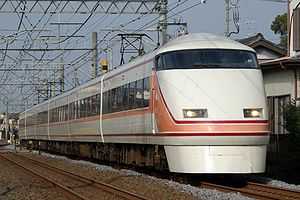Tobu 9000 series
| Tobu 9000 series | |
|---|---|
 Refurbished set 9105, July 2008 | |
| In service | 1981–Present |
| Manufacturer | Tokyu Car Corporation, Fuji Heavy Industries, Alna Koki |
| Constructed | 1981–1994 |
| Refurbishment | 2007–2008 |
| Number built | 100 vehicles (10 sets) |
| Formation | 10 cars per trainset |
| Operator | Tobu Railway |
| Depot(s) | Shinrinkōen |
| Line(s) served | Tōbu Tōjō Line, Tokyo Metro Yūrakuchō Line, Tokyo Metro Fukutoshin Line |
| Specifications | |
| Car body construction | Stainless steel |
| Car length | 20 m (65 ft 7 in) |
| Maximum speed | 110 km/h (70 mph) |
| Acceleration | 3.3 km/h/s |
| Deceleration |
3.7 km/h/s (service) 4.5 km/h/s (emergency) |
| Electric system(s) | 1,500 V DC |
| Current collection method | Overhead lines |
| Track gauge | 1,067 mm (3 ft 6 in) |
The Tobu 9000 series (東武9000系 Tōbu 9000-kei) is a commuter electric multiple unit (EMU) train type operated by Tobu Railway in Japan.
First entering service in 1981 on the Tōbu Tōjō Line, this was the first stainless steel EMU type to be introduced by Tobu. A total of ten 10-car sets were ultimately built for use on through-running services over the Tokyo Metro Yūrakuchō Line and Tokyo Metro Fukutoshin Line, as well as Tōjō Line services between Ikebukuro and Ogawamachi.
Variants
- Prototype set 9101
- Production sets 9102-9108
- 9050 series VVVF sets 9151-9152
Prototype set 9101

Built in October 1981, this was the first stainless steel EMU type to be introduced by Tobu, and featured a bodyline stripe using the same "Royal maroon" colour as previously used on Tobu 1720 series "DRC" trains.[1] Set 9101 was built jointly by three manufacturers, with four cars built by Tokyu Car Corporation, two cars by Fuji Heavy Industries, and four cars by Alna Koki (now Alna Sharyo).[2]
The seats on this set were originally brown, but this was later changed to the standard light green colour.[1]
Formation
| Designation | Tc1 | M1 | M2 | T1 | M1 | M3 | T2 | M1 | M4 | Tc2 |
|---|---|---|---|---|---|---|---|---|---|---|
| Numbering | 9100 | 9200 | 9300 | 9400 | 9500 | 9600 | 9700 | 9800 | 9900 | 9000 |
The M1 cars are each fitted with one scissors type pantograph.[3]
Production sets 9102-9108
Sets 9102 to 9107 were built in 1987, incorporating a number of minor improvements over the prototype set. Seat width was increased from 425 mm to 450 mm.
An additional set, 9108, was built in 1991, based on the 10030 series lightweight body style.
Formation
| Designation | Tc1 | M1 | M2 | T1 | M1 | M3 | T2 | M1 | M4 | Tc2 |
|---|---|---|---|---|---|---|---|---|---|---|
| Numbering | 9100 | 9200 | 9300 | 9400 | 9500 | 9600 | 9700 | 9800 | 9900 | 9000 |
The M1 cars are each fitted with one single-arm pantograph.[3]
-
First refurbished set, 9102, April 2007
-

Refurbished set 9108, March 2012
9050 series VVVF sets
Two 9050 series sets were introduced in December 1994, coinciding with the opening of the "Yurakucho New Line" (now part of the Tokyo Metro Fukutoshin Line) between Kotakemukaihara and Ikebukuro.[4] These incorporated further design improvements and changes similar to the 20050 series trains, notably VVVF control, bolsterless bogies, 3-colour LED destination indicators, LCD interior passenger information displays, and brown seat moquette. The LCD passenger information displays were removed in 1999.
Formation
| Designation | Tc3 | M5 | M6 | T3 | M7 | M8 | T4 | M7 | M9 | Tc4 |
|---|---|---|---|---|---|---|---|---|---|---|
| Numbering | 9150 | 9250 | 9350 | 9450 | 9550 | 9650 | 9750 | 9850 | 9950 | 9050 |
The M5 and M7 cars are each fitted with one single-arm pantograph.[3]
-
Set 9151 before refurbishment, March 1998
-

Refurbished set 9151, March 2012
Refurbishment
From April 2007 to 2008, all of the 9000 and 9050 series sets except prototype set 9101 underwent refurbishment ahead of introduction on Tokyo Metro Fukutoshin Line inter-running services from June 2008. Refurbishment included totally new interiors and cabs based on the 50070 series design. Externally, single-arm pantographs were fitted, and the destination indicator blinds replaced with full-colour LED displays. Prototype set 9101 was not refurbished due to the different door spacing of this set, making it incompatible with the platform doors on the Fukutoshin Line.[5] This set is restricted to Tōbu Tōjō Line overground duties.
Interior
-
Interior view of a refurbished 9050 series set, September 2012
References
- ↑ 1.0 1.1 "2006東武鉄道通勤車両カタログ" [2006 Tōbu Railway Commuter Rolling Stock Catalogue]. Tetsudō Daiya Jōhō Magazine (Japan: Kōtsū Shimbun) 35 (263): p27–30. March 2006.
- ↑ Iijima, Iwao (July 2002). 私鉄の車両24 東武鉄道 [Private Railway Trains 24: Tobu Railway]. Tokyo, Japan: Neko Publishing Co., Ltd. pp. 32–33. ISBN 978-4-87366-307-4.
- ↑ 3.0 3.1 3.2 私鉄車両編成表 2010 [Private Railway Rolling Stock Formations - 2010]. Japan: JRR. August 2010. p. 40. ISBN 978-4-330-15310-0.
- ↑ Tetsudō Daiya Jōhō Magazine (Japan: Kōtsū Shimbun): p.42. July 2008.
- ↑ Tetsudō Daiya Jōhō Magazine (Japan: Kōtsū Shimbun): p.75. June 2007.
External links
| Wikimedia Commons has media related to Tobu 9000 series. |
- Tobu 9000 series (Japanese)
- Refurbished Tobu 9000 series (Japan Railfan Magazine) (Japanese)
| |||||||||||||



